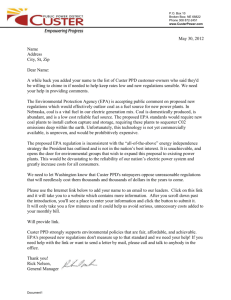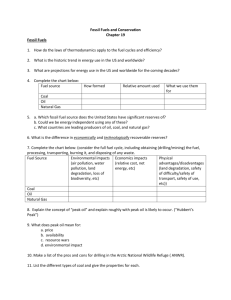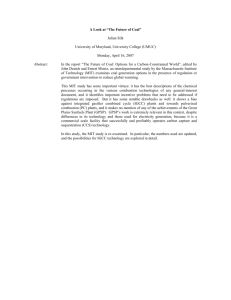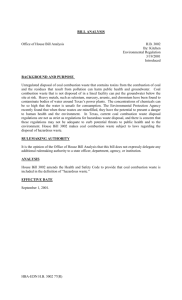CoalOilCombustion
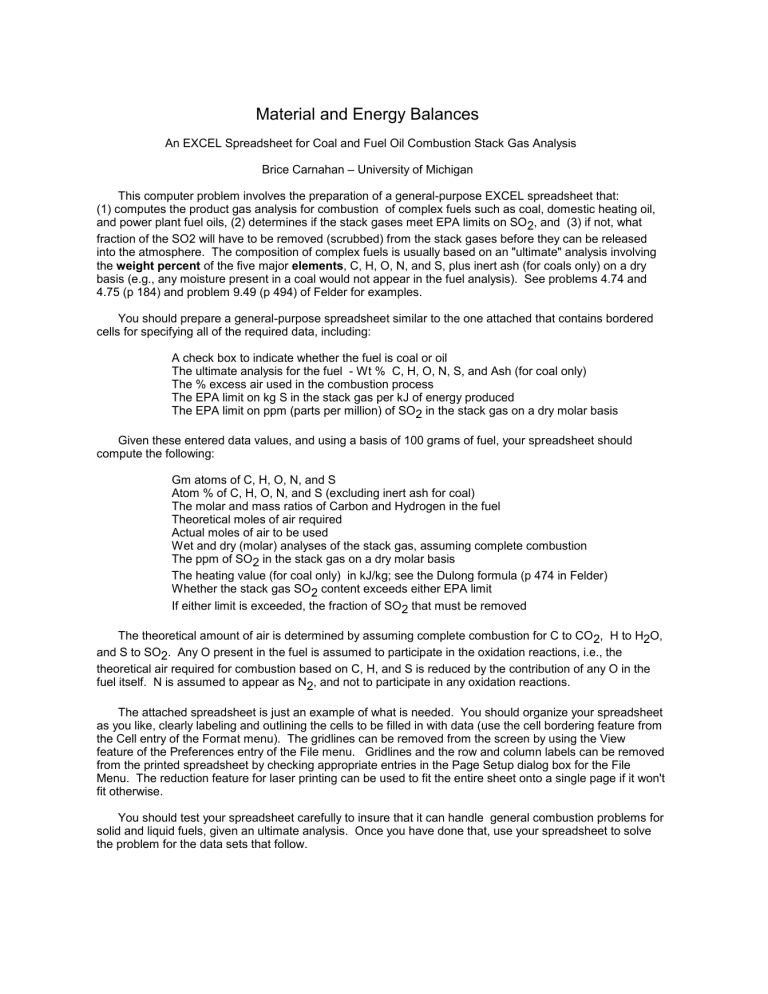
Material and Energy Balances
An EXCEL Spreadsheet for Coal and Fuel Oil Combustion Stack Gas Analysis
Brice Carnahan – University of Michigan
This computer problem involves the preparation of a general-purpose EXCEL spreadsheet that:
(1) computes the product gas analysis for combustion of complex fuels such as coal, domestic heating oil, and power plant fuel oils, (2) determines if the stack gases meet EPA limits on SO2, and (3) if not, what fraction of the SO2 will have to be removed (scrubbed) from the stack gases before they can be released into the atmosphere. The composition of complex fuels is usually based on an "ultimate" analysis involving the weight percent of the five major elements , C, H, O, N, and S, plus inert ash (for coals only) on a dry basis (e.g., any moisture present in a coal would not appear in the fuel analysis). See problems 4.74 and
4.75 (p 184) and problem 9.49 (p 494) of Felder for examples.
You should prepare a general-purpose spreadsheet similar to the one attached that contains bordered cells for specifying all of the required data, including:
A check box to indicate whether the fuel is coal or oil
The ultimate analysis for the fuel - Wt % C, H, O, N, S, and Ash (for coal only)
The % excess air used in the combustion process
The EPA limit on kg S in the stack gas per kJ of energy produced
The EPA limit on ppm (parts per million) of SO2 in the stack gas on a dry molar basis
Given these entered data values, and using a basis of 100 grams of fuel, your spreadsheet should compute the following:
Gm atoms of C, H, O, N, and S
Atom % of C, H, O, N, and S (excluding inert ash for coal)
The molar and mass ratios of Carbon and Hydrogen in the fuel
Theoretical moles of air required
Actual moles of air to be used
Wet and dry (molar) analyses of the stack gas, assuming complete combustion
The ppm of SO2 in the stack gas on a dry molar basis
The heating value (for coal only) in kJ/kg; see the Dulong formula (p 474 in Felder)
Whether the stack gas SO2 content exceeds either EPA limit
If either limit is exceeded, the fraction of SO2 that must be removed
The theoretical amount of air is determined by assuming complete combustion for C to CO2, H to H2O, and S to SO2. Any O present in the fuel is assumed to participate in the oxidation reactions, i.e., the theoretical air required for combustion based on C, H, and S is reduced by the contribution of any O in the fuel itself. N is assumed to appear as N2, and not to participate in any oxidation reactions.
The attached spreadsheet is just an example of what is needed. You should organize your spreadsheet as you like, clearly labeling and outlining the cells to be filled in with data (use the cell bordering feature from the Cell entry of the Format menu). The gridlines can be removed from the screen by using the View feature of the Preferences entry of the File menu. Gridlines and the row and column labels can be removed from the printed spreadsheet by checking appropriate entries in the Page Setup dialog box for the File
Menu. The reduction feature for laser printing can be used to fit the entire sheet onto a single page if it won't fit otherwise.
You should test your spreadsheet carefully to insure that it can handle general combustion problems for solid and liquid fuels, given an ultimate analysis. Once you have done that, use your spreadsheet to solve the problem for the data sets that follow.
Please turn in the following:
1.
Printed spreadsheets for each of the assigned problems.
2. One spreadsheet showing the cell formulas (Choose Formulas in the View tab of the Preferences entry in the File menu. If a cell formula cannot be printed completely (because of limited cell space), annotate the formula sheet with a handwritten formula.
1.
2.
3.
4.
Please use the following four data sets with your EXCEL spreadsheet.
Data Set 1 Data Set 2 Data Set 3 Data Set 4
Fuel type coal oil coal oil
Weight %
Carbon
Hydrogen
Oxygen
Sulfur
Nitrogen
Inerts
% excess air
75.80
5.10
8.20
1.60
1.50
7.80
10.0
86.50
11.70
0.00
0.66
1.14
0.00
45.0
68.82
5.10
7.57
6.66
1.01
10.84
75.0
87.20
12.50
0.07
0.22
0.01
0.00
35.0
--------
1x10-6 --- max kgmSO2/kJ max ppm SO2
2x10-6
200
These data are for the following fuels:
450 1800 300 unknown coal (Felder, p 495)
Coalinga, California crude
Illinois Saline high volatile bituminous coal, grade B
No. 2 domestic heating oil
BC

